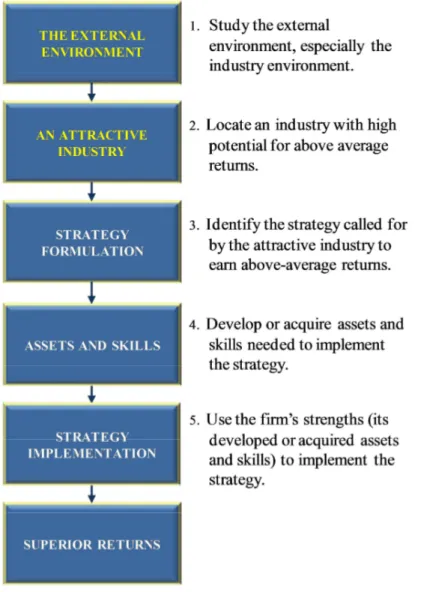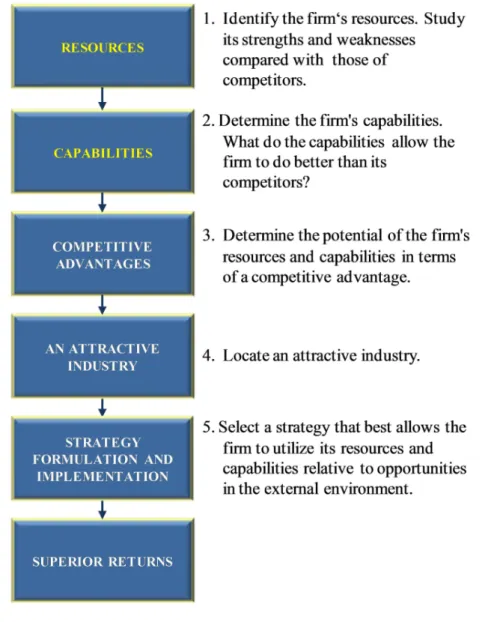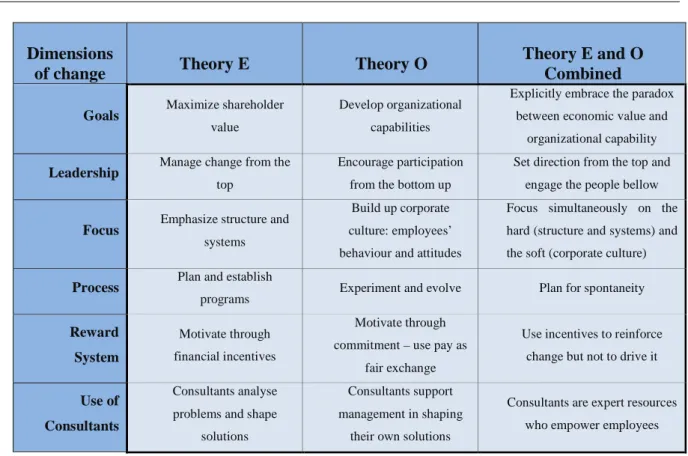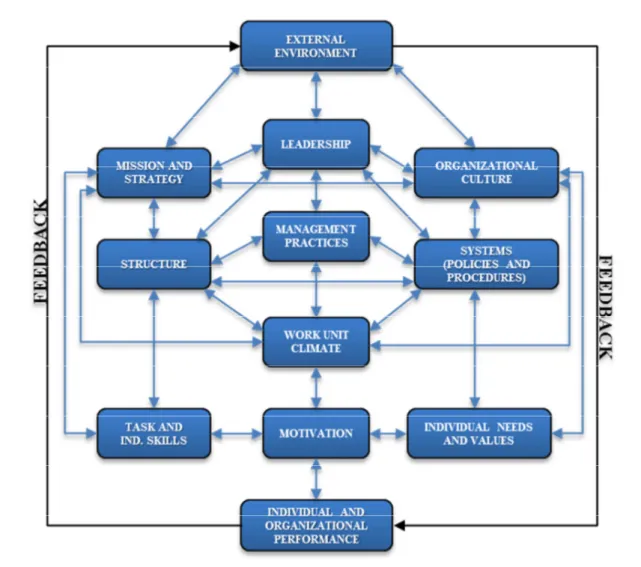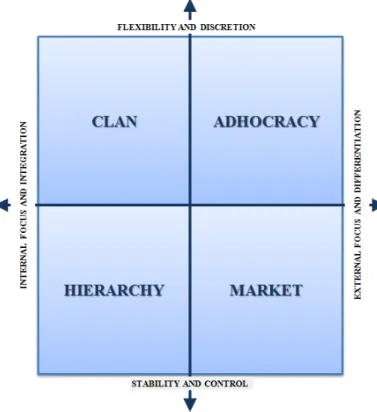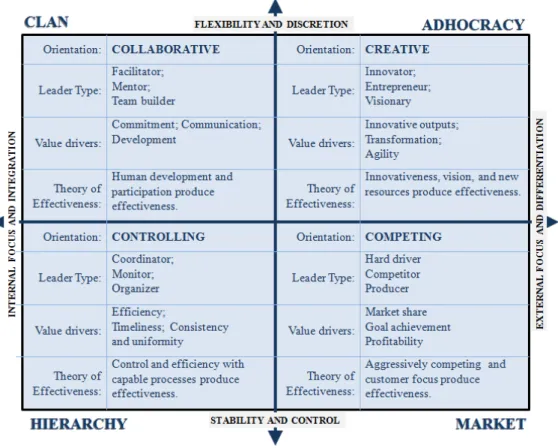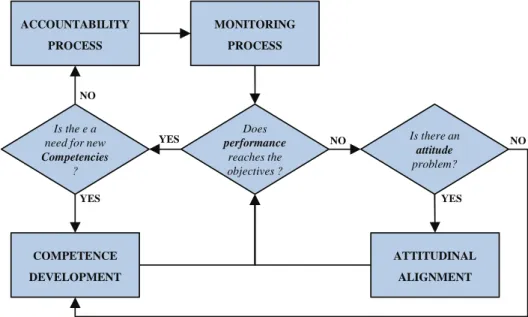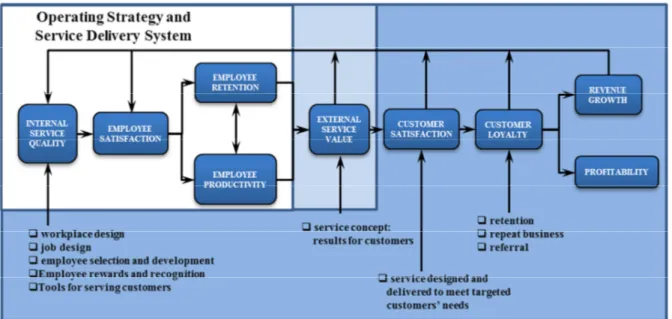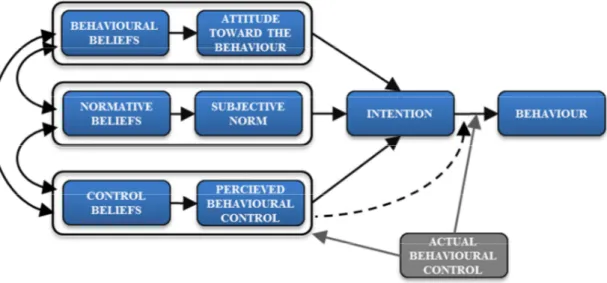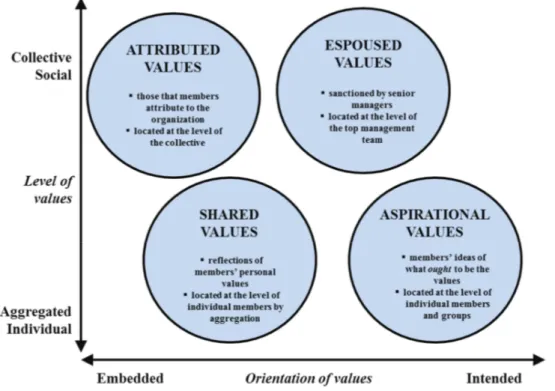Escola de Tecnologias e Arquitectura
IT Quality and Organization Development – using Action Research to promote Employee Engagement, Leadership Development, Learning, and Organizational Improvement
Telmo António Monteiro Henriques
Tese especialmente elaborada para obtenção do grau de Doutor em Ciências e Tecnologias da Informação
Júri:
Doutor João Álvaro de Carvalho, Professor Catedrático, Universidade do Minho Doutora Maria Helena Monteiro, Professora Auxiliar, Universidade de Lisboa Doutor Paulo Rupino da Cunha, Professor Auxiliar, Universidade de Coimbra
Doutor Bráulio Alturas, Professor Auxiliar, ISCTE-IUL Doutor Luís Ducla Soares, Professor Auxiliar, ISCTE-IUL
Orientador:
Doutor Henrique O’Neill, Professor Associado, ISCTE-IUL
DEDICATION
To my parents, who since an early age instilled in me values which allowed me to develop as a person.
To my wife, my son, and my daughter, my main satisfaction in life, and the most excellent fellows and advisors which one could find.
To my friends, from whom I have had the opportunity to learn, their pleasant advice often kept me at a minimal error level. Level that is high enough to allow learning from experience and low enough to encourage bypassing difficulties and progressing.
To all those persons who believe that to work with people for the benefit of people, incorprating our hearts, minds and noble values, is the most important and rewarding mission in the world. To God which inspires us to do so, for the sake of a better mankind.
ACKNOWLEDGEMENTS
To my advisor, Professor Henrique O’Neill, for his deepest support, for his patient, wise advice; allowing me freedom to experience the natural difficulties of such a singular work while, simultaneously, reminding me that I was not alone. He has been the major instiller and grantor for the success of this work and the key mentor of my growth as a researcher.
To all those excellent academics and practitioners from whom I have the pleasure to learn from, benefiting from their research, field work knowledge and experience.
Within the specific context of the excellent professional challenge which has been the Changing IT program, I would like to acknowledge all my colleagues and co-workers, whose strong engagement has allowed us to develop an amazing, new motivational and relational experience within an organization which created conditions to make it materialize. To all of them I express my deepest gratitude and recognition for their great work.
To our devoted consultants, Ricardo Vargas, Ricardo Cintra, and Ricardo Porém, I am thankful for their knowledge contribution, deep involvement, wise advice, and continuous support.
To the members of the IT Management Team, who, with visibility and engagement, entrusted us with the necessary sponsorship throughout the program.
Last but not least, to the members of the Change Agents Team, for investing all their willingness and abilities to the service of the program. This high-performance team created, and propagated to IT Employees, a solid psychological sense of community which transformed the program into a high-rewarding, challenging and transformational opportunity.
ABSTRACT
Within IT areas, Quality is often reduced to visions strongly influenced by operational and tactical instruments, relegating to minor dimensions crucial Organization Development (OD) aspects which sustain Learning, and Innovation. The current Program, grounded on the relevance of these aspects, has targeted, within a Bank’s IT Division, an approach to induce organizational change, and to produce strategic actions and behavioural changes which have led to an effective improvement on Customers, and Employees’ Satisfaction.
It has followed an Action Research paradigm – addressing a complex, transformational, planed change, and using a multidimensional, integrative approach, based on a holistic, open systemic view – not targeting for the development of new theories, but, mainly, the fulfilment of existing empirical, and methodological gaps.
It has integrated a two-cycle OD approach, where a first cycle focused on Service Culture, Leadership, and Employee Engagement has developed the conditions for a second cycle based on the acquired knowledge (double loop) and devoted to strategy implementation.
Although the intervention’s achievements cannot be generalized outside the context, they can be transposed to other settings. They’ve revealed important Management Implications which form the relevance basis for this doctoral dissertation, namely a holistic, values-based, and participative framework to address organizational transformation, and the associated critical success factors. An opportunity exists to further research in the field, linking together an OD approach with a TQM approach to organizational excellence.
Also, a metamodel of the Action Research process which has been followed – evidencing, at a conceptual level, the main sub-processes, data groups, and linking points between the action and the research dimensions – has been produced. An opportunity exists for further research on the development of this metamodel, including a conceptual data model and a system behavioural perspective (responding to events).
Keywords: Action Research, Employee Engagement, Leadership, Organizational Culture and
Values, Strategic Transformation, Organizational Development and Holistic Change, Process Improvement, Workforce Development.
RESUMO
Nas áreas de TI, a Qualidade é frequentemente reduzida a visões fortemente influenciadas por instrumentos táticos e operacionais, menorizando aspetos de Desenvolvimento Organizacional (DO) que são essenciais para sustentar a Aprendizagem e a Inovação. O presente programa, alicerçado na relevância destes aspetos, visou, no contexto da Divisão de TI de um Banco, desenvolver uma aproximação indutora de mudança organizacional; produzindo ações de índole estratégica e mudanças comportamentais; tendo conduzindo a um incremento significativo na Satisfação de Clientes Internos e de Colaboradores.
Um primeiro ciclo – focado na Cultura de Serviço, na Liderança e no Envolvimento dos Colaboradores – criou as condições para num segundo ciclo, baseado no conhecimento organizacional adquirido, e nas decisões estratégicas emergentes (“double loop” learning), proceder à respetiva implementação.
Foi seguido um paradigma de Investigação-Ação – endereçando uma mudança complexa, transformacional, planeada; usando uma abordagem multidimensional e integrativa; baseada numa perspetiva holística e de sistemas abertos – não visando diretamente o desenvolvimento de novas teorias, mas, fundamentalmente o colmatar de lacunas de índole empírica e metodológica.
Embora os resultados obtidos não possam ser generalizados fora do contexto, eles podem, contudo, ser transpostos para outras intervenções; evidenciando-se como importantes Implicações para a Gestão que integram a base de relevância desta tese: um Quadro de Referência para a Transformação Organizacional Holística, Participativa e Baseada em Valores e respetivos Fatores Críticos de Sucesso. Numa perspetiva de Desenvolvimento Organizacional abrem-se ainda oportunidades de investigação-ação futura, no mesmo contexto, progredindo para uma abordagem à Qualidade Total e à Excelência Organizacional.
Para além disso, outro dos resultados relevantes da investigação corresponde à produção do Metamodelo do Processo de Investigação-Ação que foi seguido – evidenciando, ao nível conceptual, os seus principais subprocessos, grupos de dados e pontos de articulação entre a vertente de ação e a vertente de investigação. Nesta vertente, abrem-se ainda oportunidades de investigação futura em termos de desenvolvimento do metamodelo, por forma a incluir uma visão conceptual de dados e uma perspetiva comportamental de sistema (resposta a eventos).
TABLE OF CONTENTS
1 INTRODUCTION ... 13
1.1 Strategic approach, scope, and research problems ... 14
1.2 Research paradigm ... 16
1.3 Main theoretical foundations ... 17
1.4 Intervention ... 22
1.5 Main Results and Research Contribution ... 23
1.6 Future Research Opportunities ... 25
1.7 Thesis presentation structure... 25
2 RESEARCH MEANING AND DIRECTIONS ... 28
2.1 MOTIVATION ... 31 2.1.1 Researcher’s motivation ... 31 2.1.2 Organizational commitment ... 33 2.2 PROBLEM DEFINITION ... 35 2.2.1 Organizational Problems ... 36 2.2.2 Research Problems ... 36 2.2.3 Synthesis ... 37 2.3 FORMULATION OF QUESTIONS ... 37 2.3.1 Organizational issues/questions ... 38
2.3.2 Research opportunities / questions ... 40
2.4 OBJECTIVES ... 42
2.4.1 Organizational Goals ... 42
2.4.2 Research Objectives ... 43
2.5 RESEARCH HYPOTHESIS ... 44
3 KNOWLEDGE BASE – LITERATURE REVIEW & UNDERLYING THEORIES ... 46
3.1 STRATEGIC POSITIONING ... 47
3.1.1 “Hard” versus “Soft” Approaches to Organizational Effectiveness ... 47
3.1.2 Internal Dimensions for Performance Improvement ... 54
3.2 INTERVENTION DOMAINS ... 58
3.2.1.1 The importance of organizational culture within a changing context ... 58
3.2.1.2 The meaning of organizational culture ... 59
3.2.1.3 A model for organizational culture analysis: the Competing Values Framework ... 69
3.2.1.4 The change management process associated with the reference model ... 73
3.2.1.5 The essential role of leadership on organizational culture change ... 74
3.2.2 Leadership and Team Effectiveness ... 76
3.2.2.1 Leadership theories and its vision ... 76
3.2.2.2 Team performance models and its topological evolution ... 79
3.2.2.3 Leadership and team performance models... 80
3.2.2.4 Summary and conclusions ... 82
3.2.2.5 A pragmatic view of Leader’s Responsibilities ... 83
3.2.3 Values and Employee Engagement ... 87
3.2.3.1 Values, attitudes and behaviours ... 90
3.2.3.2 Organizational Identification, its antecedents and impacts ... 105
3.2.3.3 Commitment, Psychological Sense of Community, and Extra-role Behaviour ... 108
3.2.4 Support Structures for Workforce Development ... 120
3.2.5 Process Improvement and Tool Implementation ... 123
3.2.6 Organizational Communication ... 130
3.2.7 Quality and Organizational Excellence ... 132
3.2.7.1 A brief historical overview: from craftsmanship to organizational excellence ... 132
3.2.7.2 Foundational visions of quality: Deming, Juran, and Crosby ... 134
3.2.7.3 Quality Dimensional Visions: product, process, customer, culture ... 136
3.2.7.4 Main Models associated to Organizational Excellence ... 137
3.2.7.4.1 Deming Prize ...138
3.2.7.4.2 Malcolm Baldrige National Quality Award...138
3.2.7.5 The EFQM Organizational Excellence Model ... 141
3.2.7.5.1 The Fundamental Concepts associated to Excellence ...142
3.2.7.5.2 A Global view of the Evaluation Areas and criteria ...143
3.2.7.5.3 The logic for incremental change (RADAR)...145
3.2.7.6 The importance of Leadership, People & Participation within the EFQM Model ... 145
3.2.7.6.1 Leadership ...146
3.2.7.6.2 People Management ...147
3.2.7.6.3 The importance of self-assessment for organizational improvement...148
3.3 ORGANIZATION DEVELOPMENT AND PLANNED CHANGE ... 150
3.3.1 Organization Development – definition and approaches... 151
3.3.2 Organizational Change – its relationship with Organization Development ... 159
3.3.3 The Human factor: Change related Attitudes and Behaviours ... 165
3.3.5 Major Change (transformational): Approaches, Dynamics, and Processes ... 187
3.3.5.1 Organizational Change – “hard” versus “soft” approaches ... 187
3.3.5.2 “Soft” approaches to Organizational Change: two major paradigmatic models ... 192
3.3.5.3 “Soft” approaches to Organizational Change – Integrating Values ... 213
3.4 ORGANIZATIONAL RESEARCH METHODS AND PARADIGMS ... 217
3.5 THE ACTION RESEARCH PARADIGM ... 227
4 CHANGE DESIGN AND DEVELOPMENT ... 236
4.1 ORGANIZATIONAL CONTEXT ... 237
4.2 CHANGE CYCLES ... 240
4.2.1 First OD Cycle – Setting the Strategic Ground ... 240
4.2.1.1 Intervention Program – main stages ... 242
4.2.1.2 Organizational Diagnosis ... 243
4.2.1.2.1 Reference Model ...243
4.2.1.2.2 Process...245
4.2.1.2.3 Main results...246
4.2.1.2.4 Definition of Organizational Values ...250
4.2.1.2.5 Organizational diagnostic main conclusions ...252
4.2.1.3 Service Culture Workshop ... 254
4.2.1.4 Preparation of the Change Agents Team ... 257
4.2.1.5 Communication Plan preparation ... 262
4.2.1.6 Leadership Training – Module I ... 264
4.2.1.7 Learning Meeting Cycles ... 265
4.2.1.8 Presentation of Improvement Proposals to IT Top-management... 266
4.2.1.9 Proposal Selection and Decision ... 267
4.2.1.10 Leadership Training – Module II ... 269
4.2.1.11 Program Evaluation ... 270
4.2.2 Second OD Cycle – Developing Emergent Structural Actions ... 271
4.2.2.1 IT Communication and IT Portal ... 272
4.2.2.2 IT Academy ... 273
4.2.2.3 IT Process Improvement – CMMI for Development Certification ... 274
4.2.2.4 IT Tools – Integrated Solution for Project Management ... 276
4.3 EVALUATION CRITERIA ... 277
4.3.1 Organizational Change Evaluation criteria ... 277
4.3.2 Research Evaluation ... 278
4.4.1 Organizational Culture and Values ... 283 4.4.1.1 Main Steps ... 283 4.4.1.2 Main Results ... 284 4.4.2 Leadership practices ... 286 4.4.2.1 Main Steps ... 286 4.4.2.2 Main Results ... 288
4.4.3 Employee Engagement & Participation ... 289
4.4.3.1 Main Steps ... 289
4.4.3.2 Main Results ... 290
4.4.4 Second OD Cycle – Main actions’ results ... 292
4.4.4.1 IT Communication and IT Portal ... 292
4.4.4.2 IT Academy ... 294
4.4.4.3 IT Process Improvement – CMMI for Development Certification ... 295
4.4.4.4 IT Tools – Integrated Solution for Project Management ... 296
5 REFLECTION & MAIN CONTRIBUTES ... 298
5.1 REFLECTIONS ON CHANGE RESULTS AND ITS GLOBAL EFFECTS ... 299
5.1.1 The emergence of relevant Change Results ... 299
5.1.2 The evidence of significant Change Impacts ... 304
5.1.3 The meaning of change’s results and impacts ... 306
5.1.3.1 Empirical gap ... 306
5.1.3.2 Methodological gap ... 307
5.2 RESEARCH HYPOTHESIS AND INTERVENTION FINDINGS ... 309
5.3 RESEARCH RESULTS AND CONTRIBUTE ... 315
5.3.1 A PRAGMATIC APPROACH TO THE ACTION RESEARCH PROCESS ... 317
5.3.2 A FRAMEWORK OF CRITICAL SUCCESS FACTORS FOR HOLISTIC CHANGE ... 323
6 LIMITATIONS & FUTURE RESEARCH OPPORTUNITIES ... 332
6.1 Change Evaluation Limitations ... 333
6.2 Research Limitations ... 334
6.3 Future Change and Research Opportunities... 335
LIST OF ASSOCIATED PUBLICATIONS ... 339
TABLE OF FIGURES
Figure 1 – Organizational Change Questions: formulated along the organizational intervention ... 40
Figure 2 – Research Questions ... 41
Figure 3 – Research Objectives ... 44
Figure 4 – Research Hypothesis ... 45
Figure 5 – the I/O Model of Above-average return ... 48
Figure 6 – the Resource-Based Model of Above-average return ... 49
Figure 7 - Comparing Theories of Change: Theory E and Theory O ... 51
Figure 8 - “Planned market-induced change” (Theory E) versus “Organizational Development” (Theory O) ... 52
Figure 9 – Burke & Litwin’s Model of Organizational Performance and Change... 55
Figure 10 – Schein’s three levels of Culture ... 62
Figure 11 – Cameron & Quinn’s Competing Values Framework: axis and culture types ... 70
Figure 12 – Cameron & Quinn’s Competing Values Framework: Culture types’ characteristics ... 72
Figure 13 – A pragmatic view of Leadership responsibilities: main questions and processes ... 85
Figure 14 – Heskett’s Service-Profit Chain ... 88
Figure 15 – Ajzen & Fishbein’s Theory of Reasoned Action (TRA) and of Planned Behaviour (TPB) ... 91
Figure 16 – Bourne & Jenkins’ Organizational values: espoused, attributed, shared, and aspirational ... 100
Figure 17 – Bourne & Jenkins’ Forms of Organizational values: typical overlaps and gaps ... 102
Figure 18 – Tavares’ General multilevel model for Organizational Identity Predictors ... 106
Figure 19 - Organizational Identification Consequences – Tavares’ systematization of empirical studies ... 107
Figure 20 – Meyer & Allen’s Three-component Model of Organizational Commitment ... 110
Figure 21 - OCB and Bormon & Motwidlo’s taxonomy of Contextual performance ... 117
Figure 22 - The “critical dimensions” of Business Improvement – with a focus for Processes ... 125
Figure 23 - CMMI – structural base concepts associated with a staged representation ... 126
Figure 24 - CMMI – Basic characterizations of maturity levels ... 128
Figure 25 – CMMI for Development – Maturity levels and associated Process areas (cumulative) ... 129
Figure 26 - Deming Prize: Relationships within basic categories and points ... 138
Figure 27 - Malcolm Baldrige National Quality Award: Criteria for performance excellence ... 139
Figure 28 - Malcolm Baldrige National Quality Award: Core values and concepts ... 139
Figure 29 – EFQM Model 2013: Fundamental Concepts ... 143
Figure 30 – EFQM Model 2013: Organizational Excellence base evaluation criteria ... 143
Figure 31 – EFQM Model 2013: Rationale underlying each base evaluation criteria ... 144
Figure 32 – EFQM Model 2013: RADAR incremental approach logic ... 145
Figure 33 – Conti’s contrast on Self-evaluation approaches: Award-like versus de Diagnostic ... 150
Figure 34 – Organization Development: Egan’s summary of main definitions ... 155
Figure 35 – Major Planned Change Approach Paradigms ... 160
Figure 37 – Kotter & Schlessinger’s essential approaches to deal with resistance to change ... 173
Figure 38 – Oreg et al. Model of Antecedents, explicit reactions, and consequences of organizational change ... 176
Figure 39 – Van de Ven & Poole’s Process Theories of Organization Development and Change ... 179
Figure 40 – Luthan’s Characteristics of Learning Organizations... 186
Figure 41 – Senior & Swailes’ contrasting characteristics on “difficulties” versus “messes” ... 188
Figure 42 – “Hard” and “soft” complexity: Paton & McCalman’s TROPICS factors ... 189
Figure 43 – Senoir & Swailes: The OD model for change... 192
Figure 44 – Lippit’s Seven-steps to change ... 194
Figure 45 – Kotter’s Eight-Stage Process of Creating Major Change ... 203
Figure 46 – Success Factors in Organizational Change: Boonstra’s main Principles and Insights ... 206
Figure 47 – Integrated Model of Values-based Management ... 216
Figure 48 – Contrasting relative emphases of ‘real world’ and ‘academic’ researchers ... 218
Figure 49 – Buchanan & Bryman’s System of influences on choice of organizational research methods ... 219
Figure 50 – Quantitative versus Qualitative research: typical features ... 222
Figure 51 – Axiomatic Nature of Research Paradigms: definition of Characterization attributes ... 224
Figure 52 – Axiomatic Nature of Research Paradigms: Participatory Research Characterization ... 227
Figure 53 – Action Research: Shani & Pasmore’s Definition and key characteristics ... 229
Figure 54 – Major Factors which affect the Action Research process ... 229
Figure 55 – Gummesson’s Major characteristics of Action Research ... 231
Figure 56 – Community-based Action Research: Stringer’s Working Principles ... 233
Figure 57 – Organization Development as a shift on Values ... 235
Figure 58 – Organization Development Humanistic Values ... 235
Figure 59 – Changing IT: Main steps of the organizational intervention (1st OD Cycle) ... 243
Figure 60 – Current versus Desired Culture: Global ... 248
Figure 61 – Current versus Desired Culture: Dimension Objectives ... 249
Figure 62 – Current versus Desired Culture: Dimension Values ... 249
Figure 63 – Current versus Desired Culture: Dimension Leadership... 250
Figure 64 – Current versus Desired Culture: Dimension Information ... 250
Figure 65 – Organizational Values and attitudinal triggers ... 251
Figure 66 – Current versus Desired Culture: Main dimensional characteristics ... 254
Figure 67 – Main communication events along the Changing IT Program ... 263
Figure 68 – Second OD Cycle: Main initiatives emerged from the Changing IT Program ... 271
Figure 69 – Changing IT: Evaluation instruments ... 277
Figure 70 – Changing IT – Service Culture and Values: Stages, Objectives, and Evaluation Instruments ... 283
Figure 71 – Changing IT – Leadership Practices: Stages, Objectives, and Evaluation Instruments ... 286
Figure 72 – Changing IT – Engagement & Participation: Stages, Objectives, and Evaluation Instruments ... 289
Figure 74 – Sustained evolution of Employees and Internal Customers’ Satisfaction Levels ... 304
Figure 75 – Research Hypothesis and the Major Findings emerging from the Intervention ... 314
Figure 76 – Action Research: Main Processes and associated Data (our Applied Process Metamodel) ... 319
Figure 77 – An integrative Framework of Critical Success Factors for holistic transformational change ... 325
Figure 78 – Research Hypothesis and the Framework of Critical Success Factors for Holistic Change ... 331
1.1 Strategic approach, scope, and research problems
Within Information Systems and Technology areas, Quality and Organizational Excellence are often reduced to some visions, strongly influenced by operational and tactical instruments (COBIT, ITIL, CMMI, and PMBOK), which tend to overvalue the process, risk, control, and service dimensions of the organization.
These are, undoubtedly, important dimensions of Information Systems Management, but they are not sufficient to represent the kernel determinants of organizational effectiveness. This is particularly important when addressing problems associated with holistic transformational change.
As a consequence of this restrict vision, some of the important Organization Development aspects which are crucial to any Quality and Innovation Strategy – including, among others, Organizational Culture and Values, Leadership, Work Teams, and Employee Engagement – are relegated to a minor dimension.
On a Strategic Management perspective, Hitt, Ireland and Hoskinsson (2009) enhance, on the Resources Based Model, an approach which starts from the organization’s unique resources and capabilities – taken as potential competitive advantages – to identify attractive market segments and activities, and using them as a foundational basis to develop strategies targeting “above average results”.
Focusing on a resource centred view, Burke & Litwin (1992) enhance, on its Causal Model of Organizational Performance and Change – as crucial aspects on the basis of individual and organizational performance – a set of important internal dimensions to be considered. They include Leadership, Management Practices, Work Unit Climate, Motivation, Organizational Culture, and Individual Values and Needs.
Focused on Ethical aspects – and arguing that “organizational ethics is the result of leaders’ practices”, being its main responsibility “to manage team’s culture, allowing for the introduction of predictability on Mission and Vision implementation” – Vargas (2005) enhances the dual importance of integrating the “material” (strategy, structure, processes, and competencies) and “immaterial” (values, beliefs, norms, and attitudes) dimensions of organization life, in order to effectively implement its Mission and Vision. He deeply discusses and develops, in a logic
sequence, all the essential aspects for implementing an integrated value-based management model.
This is the strategic vision orientation which is subjacent to the first Organization Development cycle associated with the current organizational intervention and research.
This first cycle, devoted to Strategy Determination, has been the main focus of the research. Within a real organizational context, our primary research problem was the identification of a structured set of Critical Success Factors for holistic, participative and transformational change. Another main problem, to be addressed along the change and research process, was centred on the establishment of a model for the process itself – including a structured set of typical activities and the associated main data – integrating the action and research dimensions as a whole, and balancing research rigor with organizational relevance. This was a clear and immediate operational problem, but it was also an opportunity to conceptualize, develop, and improve on the research method itself. So, the emerging model would be necessarily specific and pragmatic to be successfully applied, and tested within context, but also sufficiently generic (as a process and data meta-model) to be considered as relevant for further application outside the context.
A second organization development cycle – focused on Implementation and founded on the Organizational Transformation proposals and main decisions which have emerged from the first one – has covered a set of main Strategic Actions, setting new policies, structures, and procedures, and targeting structural improvement within areas such of Employee Training and Development, Communication, Leadership Practices, adoption of IT Best Practices, Process Optimization, and Tool Implementation.
Despite this second cycle, devoted to Strategy Implementation, is not directly related to our focal research problem, questions, objectives, and hypothesis, it has been considered as relevant, from an Organization Development perspective, to provide a clear evidence of its strategic outcomes.
In fact, it inclusion within this dissertation is strictly instrumental. So, it is here described, on its essential actions and major outcomes, only for the purpose of giving evidence of the change success and strategy sustainability. It also provides some useful information about the case, from an organizational management perspective.
According to Argyris (2002) learning may be defined as the “detection and correction of error”, existing a clear distinction between single-loop learning, which “occurs when errors are corrected without altering the underlying governing values” and double-loop learning, which “occurs when errors are corrected by changing the governing values and then the actions”.
Senge (2006:p. 766), rooted on these concepts, and developing the theme of the role of the Leader on building Learning Organizations, refers a clear distinction between the notions of generative learning, “which is about creating”, and adaptive learning, “which is about coping”.
Together, both cycles of this large organizational transformation integrate and configure a double-loop, generative, organization development and learning process; covering strategy definition and implementation; and having, as a common characteristic, an underlying strong investment on people involvement along its preparation, as well as along the subsequent improvement initiatives supported by new structural units and processes.
1.2 Research paradigm
Referring to Organization Development, Cummings & Worley (2009) – enhancing its intrinsic strong relation with Planned Change – consider this process as:
“A system wide application and transfer of behavioural science knowledge to the planned development, improvement, and reinforcement of the strategies, structures, and processes that lead to organization effectiveness”.
Concerning this kind of change they refer three major theoretical frameworks for organizational transformation, namely the classic model of Kurt Lewin (1951), the Action Research paradigm (Herr & Anderson, 2005), and the Positive Approach (Cooperrider & Whitney, 2005).
Focusing on the Action Research paradigm, Shani & Pasmore (1982) define it as:
“An emergent inquiry process in which behavioural science knowledge is integrated with existing organizational knowledge and applied to solve real organizational problems”, being “simultaneously concerned with bringing about change in organizations, in developing self-help competencies in organizational members, and in adding to scientific knowledge”.
Not being the objective of the current organizational interventions to address directly any theoretical gap – but, mainly, to fill an empirical gap, and a methodological gap, using existing internal and external knowledge to promote learning and change, and reflecting on what has been done and achieved to produce relevant knowledge emerging from its application – the Action Research paradigm has been considered as the most adequate for this purpose.
1.3 Main theoretical foundations
According to the main organizational problems to be addressed, a deep transformational change should occur, primarily on the domains of Organizational Culture and Values, Leadership, and Team Effectiveness, and Employee Engagement. So, these were the main areas covered by the first OD intervention cycle.
Along a wide participative and generative learning process, it has prepared the ground to face, on a second cycle, a new set of interrelated projects; developing Support Structures for Workforce Development, targeting Process Improvement and Tool Implementation, enhancing Organizational Communication, and promoting Quality and Organizational Excellence.
So, relevance must be given to all these foundational aspects.
On a broad vision of Organizational Culture Cameron & Quinn (1998) detail essential aspects of their approach: the Competitive Values Framework. It supports a diagnostic stage, on the understanding of the existent culture and on the determination of the essential aspects of the desired culture. For the purpose they have designed a process and a proper questionnaire (Organizational Culture Assessment Instrument).
Due to this wide vision over Organizational Culture, its rigorous and well-tested approach, it has been considered, and adopted, as our initial organizational diagnosis tool.
Concerning Leadership and Work Team Effectiveness, several publications highlight the leader influence on team performance and its determinant role concerning transformational change. Important theories give relevance to multiple approaches to Leadership, including the Treats approach, Charismatic and Visionary leadership, Skills, Styles, Functional leadership, Leader-Member Exchange, and Transformational leadership (Northouse, 2007).
Associated with Employee Engagement, multiple constructs – including Values, Attitudes, Behaviours, Organizational Identification, Engagement, Empowerment, and Extra-Role
Behaviour – form a critical basis for organizational effectiveness, supporting the “soft” dimension of organizational strategy.
On the domain of values, attitudes, norms, and behaviours, several important studies (Allport, 1954; Fishbein & Ajzen, 1975, 1980; Alcobia, 2001) enhance its relevance and strong implication over organizational performance.
Organizational identity and identification, “positively connected with cohesion and cooperation, motivation, performance, and extra-role behaviour” (Tavares, 2007), are essential to promote individual well-being and organizational effectiveness.
The alignment of organizational values (espoused, attributed, shared, and aspirational) is a major vehicle to promote and sustain change (Bourne & Jenkins, 2013).
Espoused Values, mediating Artifacts and Assumptions on Schein’s (2009) model of Organizational Culture, play a major role. They explain “why the members of the organization are behaving as they do, and why each organization is constructed as it is”.
Commitment, and particularly affective commitment has “the strongest and most favourable correlations with organization-relevant (attendance, performance, and organizational citizenship behaviour) and employee-relevant (stress and work–family conflict) outcomes" (Meyer & Allen, 1991; Meyer et al., 2002).
Psychological Sense of Community – recently transposed to the field of management by Boyd & Nowell (2014) – aggregates several dimensions (membership, influence, integration and fulfilment of needs, shared emotional connection, and responsibility) with relevance to “rebuild companies as communities for the long-term success of the firm” (Mintzberg, 2009).
Extra-role discretionary behaviours, namely Organizational Citizenship Behaviour, are essential to “promote the effective functioning of the organization” (Organ, 1988).
Communication, participation, and facilitation are key strategic drivers to “positively influence specific individuals and groups during a change process” (Kotter & Schlesinger, 1979).
Being the firm a “unique integrated system of structure-plus-processes-plus-culture” (Vargas, 2005), the integration of these three dimensions is crucial to organizational success.
They are the result of “a set of choices, along organizational history”, which determine its uniqueness, identity, and differentiation.
Particularly its culture – strongly influenced by employees and their leaders, within groups, and shaping the whole organization – determines essential aspects of organizational life: “formal interaction patterns, shared working norms, beliefs about essential business aspects, values, informal decision taking criteria, community belonging regulation, tactical agreements, and conduct and communication codes”. They are critical aspects for organizational development with strong implications on firms’ effectiveness.
Individual engagement is an essential ingredient of active participation in self-assessment processes; on the basis of several approaches to organizational excellence (e.g., EFQM, 2013). These were the main theoretical references associated with the work which has been developed along the 1st cycle of the intervention (Strategy Determination).
For the 2nd cycle (Strategy Implementation), the focus has been set on Employee Training and Development, Organizational Communication, Adoption of Best Practices, Work Process Optimization, and Supporting Tools Implementation.
Concerning Employee Training and Development, Meister (1998:22) enhances its evolution to a completely new paradigm, “from training to learning”, with new characteristics – including
“anywhere, any place, building core workplace competencies, incorporating action learning, shifting from individual to team, developing corporate universities, facing learning as a continuous process, and focusing on real problem solving”.
The Corporate University, “as a metaphor for learning”, represents a cohesive structure, with proactive focus, strategic scope, enrolling on just-in-time learning, and increasing on-the-job performance.
It should not only cover “traditional” training, but address (p. 90) new areas:
• “corporate citizenship” (culture, values, traditions, and vision),
•“contextual framework” (grounding employees on an appreciative vision of the company, its customers, competitors, and best practices), and
•development of “core workplace competencies” (learning to learn, communication and collaboration, creative thinking & problem-solving, technological & global business literacy, leadership development, and career self-management skills)”.
Organizational communication plays a central role on organization development and change. Krone, Kramer, & Sias (2010) refer that it has expanded “to address the effects of small group networks, superior-subordinate communication, and communication climate on employee satisfaction and performance”.
Jones et al. (2004) enhance the need to “understand the communication of organizational change”, and to “explore diversity and the intergroup aspects of communication”.
Concerning participative processes, Seibold & Shea (2001:665) enhance its role, asserting that “communication may moderate the effects of various types of participation or involvement programs”.
These were the main foundations concerning the theoretical line of thoughts and orientations applied during the Strategy Implementation Cycle, and which address the Organization Development dimensions of the organization which point out to address the “people” dimensions of the organization – targeting ndividuals, groups, teams, and the organization as a whole.
As previously argued they integrate a kernel, no negligible, dimension, which is a major determinant of organizational effectiveness.
However, despite being a foundational basis of the organizational system, it must be integrated, on practice, with adequate formal processes and tools.
So, a major reference must be given here concerning the last essential aspects of its theoretical foundations and “best practices” which, being relevant for the IS/IT areas, were considered as relevant orientations and principles applied during the second cycle of the intervention.
On software process improvement (SPI) Muller, Mathiassen, & Balshoj (2010) emphasize that a significant number of publications on the subject address SPI with a primary focus on organizational change. They refer strong evidence that “effective management of change during SPI requires serious consideration of context and underpinning values”.
One of the most used frameworks for assessing software development process maturity is the Capability Maturity Model Integration (CMMI) from the Software Engineering Institute. It integrates a set of “best practices that help organizations to improve their processes” (CMMI Product Team, 2010; Chrissis, Konrad, & Shrum, 2011), and specific orientations for a formal appraisal process (SCAMPI Upgrade Team, 2011) conduction to a certification.
Its staged “CMMI for development” representation considers, for maturity level 2, seven main practice areas to be evaluated: requirements management, project planning, project monitoring and control, supplier agreement management, measurement and analysis, process and product quality assurance, and configuration management.
Essentially, these areas focus around project management, as an initial basis to, along further levels, promote best practices’ “institutionalization”.
So, adoption of project management best practices (e.g., as prescribed in PMI, 2013) should be considered as important initiatives to support a software process improvement progression to this level of maturity.
The implementation of a flexible and extensible IT project management tool, covering most of these practice areas with the necessary process and data, is essential to sustain a controlled environment; facilitating the progression to upper levels of maturity.
Planed transformational changes (as characterized by Porras & Robertson, 1992; Van de Ven & Poole, 1995; Caetano, 2001; Weick & Quinn, 1999; Tushman & Romanelli, 1985) – covering socio-technical aspects within the organization, following a systemic view, and targeting double-loop organization development and learning (Argyris, 2002) – should not act over isolated aspects of organizational life, following a mecanicist view. They, necessarily, must consider all the relevant dimensions as being part of the whole; integrating people, group, inter-group, and organizational levels onto a dynamic living paradigm.
In fact, positivistic and reductionist views of organizational systems – although giving important contributes to explain isolated parts of the whole phenomena; identifying relevant constructs and variable dependencies; and providing relevant knowledge as a basis for organizational interventions – are not sufficient to study and test global mechanisms and pre-conditions associated to the whole system which must be present in order to produce major transformational changes inside real organizations.
These were the main assumptions and theoretical references for the work which has been developed along this two-cycle intervention.
Its deeper analysis and development will be further covered in the Chapter entitled as “Knowledge base – Literature Review and underlying theories”.
1.4 Intervention
The current set of interventions has been developed within the Information Technology unit of a major Portuguese Bank which provides application development and infrastructure management services to all the organization; having internally about 500 employees, and holding a structured outsourcing contract, for IT infrastructure, with a major IT international supplier.
The intervention has started with a Diagnostic phase, where – through a proper questionnaire (OCAI, Cameron & Quinn, 1998), a set of focus group sessions, and a group of semi-structured interviews – it has been possible to obtain a “picture” of the current culture, as well as an image of the desired culture.
These actions have involved all employees and its managers / leaders, as well as top-representatives of the main internal customers. They facilitated a better identification of existing gaps, and associated problems; providing a good basis to tailor (design and plan) the intervention.
The first cycle of the program – named as Changing IT – has been mainly developed along 2009, and has involved all the IT Unit employees.
Communication, engagement, action, and improvement were the most relevant attributes of the process.
It has integrated a structured set of actions with the main objectives of developing a Service Culture; harmonizing more effective Leadership practices, and promoting extensive Employee Engagement and Participation.
It has been set-up and implemented by an internal team, supported by external consultants, coordinated with the IT management team, facilitated by a Team of Change Agents, and sponsored by IT top-level management.
The second organization development cycle – integrating a set of strongly interrelated structural actions, targeting Employee Satisfaction, Motivation, and Teams Effectiveness, within areas such as Training, Development, and Communication, Leadership practices, Best Practices Adoption and Work Process Optimization, and Supporting Tools Implementation – has implemented new strategic directions (as an organizational learning effect from the 1st OD cycle) using specific project teams, IT top-management sponsorship, specific Steering Committees, and benefiting from a wide support and cooperation provided by all employees directly involved.
Concerning the kind of change (Porras & Robertson 1992) which has been promoted along this two-cycle organization development program, it can be classified as a 2nd order planned change (multidimensional, multi-level, radical, and discontinuous; involving an organizational paradigms rupture), this is, transformational; targeting “changes in organizational climate and culture, with significant changes on working processes, organization structure, conception, and management, according to a previous plan” (Caetano, 2001).
It configures a scenario of planed change (Van de Ven & Poole, 1995) built at the level of a single entity – with development induction through a cycle of goal formulation, implementation, evaluation, and modification of goals based on what was learned.
According to Weick & Quinn (1999) it can be characterized as an episodic change (infrequent, discontinuous, and intentional) occurring during divergence periods; where organizations are moving away from their equilibrium conditions (Punctuated equilibrium model, Tushman & Romanelli, 1985).
In fact, the 1st cycle (strategy determination and engagement), together with the 2nd cycle (implementation of structural actions), exhibit these characteristics and configure (Argyris, 2002) a double-loop organization development and learning process.
Details concerning the Action Research problems, questions, objectives, and research hypothesis will be exhaustively detailed within the Chapter “Research Meaning and Directions”, being the aspects associated with the organizational context, the diagnosis, development, and evaluation of the intervention presented at the Chapter entitled as “Change design and development”.
1.5 Main Results and Research Contribution
By the end of the Chapter entitled as “Change design and development” the essential aspects of Change evaluation criteria and results, covering both cycles of the intervention, will be exhaustively presented. Following this, at the beginning of the Chapter entitled “Reflection & Main contributes” a proper reflexion is made over these main results and its global effects, as a previous step to the evaluation of Research results.
It includes, as most significant:
• new positive problem solving practices;
• enforced Organizational Commitment and Employee Engagement; • enhanced Psychological Sense of Community;
• significant improvement of Leadership practices; • strong enforcement of Internal Communication; • relevant Strategic Initiatives;
• new Organization Development Structures; and • improved Processes, Tools, and Practices.
Besides these prominent results (which solved relevant strategic problems within the organization) a global chain of effects must highlighted: a high increase on Employee Satisfaction, followed by a relevant improvement on Service Quality, promoting high levels of Customer Satisfactions, and a relevant Internal and External Recognition.
From a theoretical point of view these results and achievements mean that an empirical gap (solving problems within context and introducing direct improvements with evident results), as well as, a methodological gap (developing a set of methods and procedures within the organizational settings, thus inducing learning with capability for future application) have been fulfilled.
From the action research intervention, also relevant research findings must be highlighted as emergent knowledge. In fact, within the context of this research two main contributes have emerged.
They correspond to theoretical meta-knowledge which can be further applied on subsequent interventions by practitioners, or used to develop new academic research.
So, this emergent knowledge must also be considered as a relevant theoretical contribute.
The first one is a Framework of Critical Success Factors for Holistic Change. It is directly related with the achievement of the research objectives and hypothesis confirmation.
The second corresponds to a Pragmatic Approach to the Action Research Process. It has been developed and tested along the intervention. It identifies and describes the main sub-processes and data of Action Research which is collected and updated along the process.
Both are extensively detailed, in a comprehensive form, at the end of Chapter entitled as “Reflection & Main Contribute”.
1.6 Future Research Opportunities
Having the intervention prepared people, structures, and systems to address new levels of Quality (including mobilizing dynamics; reframed values and behavioural systems; increased self-confidence and trust; organization-wide skills and competencies; participation mechanisms; new tools and processes) an opportunity exist to use these results and tools (which have become effective) to take a second step towards Organizational Excellence. A self-assessment process, conciliating a diagnostic approach with an award-like approach, following the EFQM Model, is an effective research opportunity which can be conducted within these organizational settings. Another research opportunity exists in order to test and complete the Pragmatic Approach to the Action Research Process which has been developed.
These are the two main opportunities that, among others, are further detailed at the Chapter entitled as “Limitations and future research opportunities”.
1.7 Thesis presentation structure
An Action Research Dissertation, due to its specific nature and characteristics (quite different from a positivist traditional approach), must give evidence and enhance a set of important aspects which emphasize its own purpose, nature, validity, and outcomes.
As referred by Herr & Anderson (2005:1):
“Dissertations in the social sciences are not what they used to be. Before the advent of more qualitative and action-oriented research, advice on how to do the standard five-chapter dissertation was fairly clear. Students were advised to begin in linear fashion, producing the first three chapters for the proposal defense and then adding a chapter to report findings and another for implications and recommendations after the data were gathered and analyzed”.
And the authors proceed, stating that:
“While action research shares some similarities with qualitative research (and even quantitative research), it is different in that research participants themselves are either in control of the research or are participants in the design and methodology of the research”,
highlighting that, while
“Traditional researchers see their impact on the setting either as positive (as using carefully planned and controlled treatments in an experimental design) or as negative (as contaminating or distorting ongoing events in a natural setting)”,
the action research dissertations
“Contain a local perspective that few traditional researchers are able to provide”, which forces the researcher to “think not only about what knowledge they have generated that can be fed back into the setting (local knowledge) but also what knowledge they have generated that is transferable to other settings (public knowledge)”.
This implies that, to give evidence of, both, rigor and relevance, an Action Research Dissertation must balance all these aspects, thus implying a structure that is quite distinct from the previously referred “five-chapter dissertation”.
According to this, the main chapters of this Doctoral Dissertation, thus, develop the essential aspects related to the research which has been conducted, including:
• Chapter 1: Introduction – an introductory summary of the essential aspects associated with the action research work which has been developed: strategic approach, research paradigm, main theoretical foundations, intervention, main results and contribution, and future research opportunities;
• Chapter 2: Research Meaning and Directions – including motivation, problem definition, the formulation of research questions, objectives, and research hypothesis;
• Chapter 3: Knowledge Basis – a result of the literature review, detailing (1) the strategic positioning and (2) the main theoretical basis associated to the domains of the intervention, which together form the knowledge starting point to plan, design, and implement the associated transformational change; also including details concerning (3) essential aspects related to major Organization Development and Change approach strategies; as well as with (4) Organizational Research Methods and Paradigms; and, further on, focusing on the (5) Action Research Paradigm from an insider researcher positionality;
• Chapter 4: Change Design and Development – presenting the Context; the details for each of its two Development cycles; Evaluation criteria; Results; and main Achievements;
• Chapter 5: Reflection & Main Conclusions – reflection on the change intervention, its results, and global effects; detailing the specific approach to the action research process; and highlighting the research results and contributes;
• Chapter 6: Limitations & Future Research Opportunities – exposing some restrictions and limitations inherit to the research, as well as, some interrelated and interesting subsequent research opportunities.
In order to make sense for the research – and, simultaneously, to focalize, plan, and design in advance the essential aspects of the associated organizational intervention – it is necessary to predefine (and to give evidence of) the main underlying problems, its definition, associated issues, questions to be addressed, objectives, and research hypothesis to be confirmed on action within the organizational settings where the research takes place.
Concerning this, Coghlan & Brannick (2010) referring to the Dissertation Proposal as
“Your statement that what you intend to do is such that you know what you are getting yourself into (through showing familiarity with both the organizational setting and some relevant literature), that what you intend to do is worthwhile, and that you have a potential contribution to knowledge to make”,
identify (p. 60) four areas that an insider action research proposal needs to address, namely:
• “Context – referring the social and academic context of the research;
•Action – covering the basic thrust of the action intended to be taken or leaded;
•Research – describing the focus of inquiry in action;
•Insider action research – bringing the focus specifically on insider inquiry”.
For each of these areas, they identify a set of initial typical questions which must be addressed as part of the research proposal, providing a clear separate set for the Action:
“what is the action?; what is the rationale for this action?; why is it worth doing?; what is the desired future?; what is the present situation?; what is the plan to move from here to there?; what is the time schedule?; with whom will you collaborate?; where do you, as the researcher, fit into the action?; what are the ethical challenges?”,
and for the Research:
“What is the rationale for researching this action? What is the contribution to knowledge that this research intends to make? How do you intend to inquire into the action? How do you ensure quality and rigour in your action research?”
Referring to the writing of an Action Research Dissertation (p. 143) – in particular to its purpose and rationale – they enhance that
“When you present the purpose and rationale of your research you are, in effect, presenting its academic context, which involves stating why the action you have chosen is worth doing, why it is worth studying and what it is that it contributes to the world of theory and practice”. With an explicit reference to meta-learning in Action Research (pp.11-12) they denote that in any action research project
“There are two action research cycles operating in parallel: one cycle, concerning constructing, planning, taking action and evaluating in relation to the achievement of the project's aims; and another one, corresponding to a reflection cycle which is an action research cycle about the action research cycle”.
Citing Zuber-Skerritt & Perry (2002), they adopt the denomination for a core (1st one) action research cycle and for a thesis (2nd one) action research cycle, both of them applicable to research for academic accreditation.
Referring Argyris (2003) – which argues that “this inquiry into the steps of the cycles themselves is central to the development of actionable knowledge” – the authors corroborate that
“It is the dynamic of this reflection on reflection that incorporates the learning process of the action research cycle and enables action research to be more than everyday problem solving”, thus being “learning about learning - in other words, metalearning”.
Evoking Mezirow's (1991) forms of reflection – operating at the individual, interpersonal, and organizational levels, and crossing four main territories (intentions, planning, action, and outcomes) – the authors claim that “action research aims to develop awareness, understanding and skills across all these territories”, stating that
“As an action researcher you try to understand your intentions, to develop appropriate plans and strategies, to be skilled at carrying them out, to reflect on how well you have carried out the plans, and to evaluate their results”.
Based on this knowledge and recommendations – having, however, the clear conscience that the action and the thesis dimensions (as defined by Zuber-Skerritt & Perry, 2002) are strongly interleaved along all the research cycles (thus, being not dissociable) – the current dissertation adopts a structure where they are made explicit individually.
This applies particularly to the topics concerning Problem Definition, Question Formulation and Objectives.
2.1 MOTIVATION
Motivation to engage on a wide, complex and transformational research and change project needs, at least, two evident pre-conditions: researcher’s motivation and organization’s commitment.
2.1.1 Researcher’s motivation
Concerning the individual researcher’s motivation Osborne, Marks, & Turner (2004), which have conducted a large-scale study in the UK exploring the decision making of mature students to return to education, have identified six categories of people: “delayed traditional student”, “late starters who have undergone a life-changing event”, “single parents”, “careerists wanting to progress in their existing jobs”, “escapees to get out of dead-end jobs”, and “personal growers”.
These categories highlight distinct motivating factors that may encourage people to re-enter education, while at the same time the categories reinforce how older students are taking on study often under very different circumstances to their younger peers.
For “personal growers” they found three positive factors influencing the decision to become a student: (1) “interest in the subject”, (2) “opportunity presents itself now”, and (3) “prove that I can do it”. For “late starters” they identified positive factors, including: (1) “cathartic experience as stimulus”, (2) “current opportunity –‘time for me’”, (3) “self-belief – ‘If they can do it so can I’”, and (4) “altruism”.
Being responsible for an IT Quality Improvement and Organization Development unit; having (1) a past experience in Management Consultancy; (2) a special learning and research interest on Organizational Change; and (3) a specific major Organizational Transformational Program on hands; has been (using a heat-fuel-oxidizing and means-motive-opportunity allegory) the main triangle to ignite this action research project, producing a chain reaction, and targeting, simultaneously, significant organizational improvement results, relevant learning, and emergent actionable knowledge.
According to this and to my personal characteristics, I believe that my motivation tends to clearly classify me as a “personal grower”, with some motivational characteristics of a “late starter” (or, at least, blended with a certain dosage of altruism).
Coghlan (2006), focused on Insider Action Research Doctorates, and reflecting on the executive action research doctorate in terms of the
“engagement of the individual manager–researcher in first person inquiry, the collaborative activities with others in second person inquiry and the third person contribution of actionable knowledge to the practitioner and academic communities”, synthesizes quite well, the set of characteristics, issues, roles, and outcomes associated with this kind of organizational research process which, in my mind, has triggered the decision to face this personal challenge.
Specifically, among other relevant aspects, he refers, in a very seductive form, some bullet points which – for a researcher interested in the development of its own organization and knowledge – belong to his critical motivational path to decision:
•“participants undertake a research project as insiders of their own organizations, frequently through an action-oriented approach such as action learning and action research;
•Such research aims at generating actionable knowledge, which can be defined as knowledge that is useful to both the academic and practitioner communities;
•They also foster the development of the executives as practitioner–researchers;
•The context for insider research, particularly insider action research is the strategic and operational setting that executives confront in their managerial working lives;
•Issues of organizational concern, such as systems improvement, organizational learning, the management of change and so on are suitable subjects for action research, since (a) they are real events which must be managed in real time, (b) they provide opportunities for both effective action and learning, and (c) they can contribute to the development of theory of what really goes on in organizations;
•Executives who undertake an action research project in and on their own organization do so while a complete permanent member, by which is meant, that they want to remain a member within their desired career path when the research is completed;
•The researchers are already immersed in the organization and have built up knowledge of the organization from being an actor in the processes being studied. This knowledge comes from the actor engaging in the experiential learning cycles of experiencing, reflecting, conceptualizing and experimenting in real life situations;
•The primary purpose of action research is to produce practical knowing which is embodied in daily actions by the manager–researcher and the development of learning organizations and which aims to guide inquiry and action in the present”.
Being appointed as program manager for this major organizational intervention, I could not find any better set of arguments to denote the characteristics which have motivated me to embrace this challenge, following such an interesting insider research paradigm.
Now, after the research, I also add one simple, but seducing, ingredient: “to work with persons, for persons, on behalf of persons – simultaneously developing my personal skills, my engagement with people, and changing the way they look and feel their organizational world”. Using a dualism between process and results – often found on organizational and personal improvement’s discourse – I found myself working with enthusiasm for my organization; improving my own knowledge; developing myself; getting satisfied with the process; being aware of the results; planning for new developments; acting; and, again, getting new results, reflecting on it, and engaging for the next cycle.
Due to this, my final reflection on the subject told me that:
“Individual motivation is not just a state of mind, but, also, an ongoing process, which must be (self) stimulated, engaging our self on higher levels of relevant action and values”.
2.1.2 Organizational commitment
Although necessary, strong researcher’s motivation is, undoubtedly, not sufficient to trigger, develop, implement, and sustain this kind of research which is combined with an organizational change cycle.
Active Organizational Commitment is also a critical condition for the success of such an endeavour; particularly when Individuals and Groups are the main targets and agents of Change.
Buchanan & Bryman (2011:pp.6-7) – concerning the “system of influences on choice of organizational research methods” – refer, among others, some aspects related to “political properties”, enhancing that
“Researchers are routinely engaged in political actions in at least four ways, when negotiating research objectives, obtaining permissions to access respondents, aligning with stakeholder groups, and when attempting to publish findings”.
Citing Korczynski (2004), and using the term “gatekeeper” (as “anyone in a position to decide whether or not a research Project can proceed at a given site”) they clearly refer that:
“Researchers often find themselves negotiating their objectives with the 'gatekeepers' who can sanction or block their work”.
Following a positive path to organizational change several authors (e.g., Armenakis et al., 1993); Miller, Johnson, & Grau, 1994) refer readiness, openness, sponsorship, and commitment to change as favourable conditions to create active engagement and involvement to lead and participate on challenging change programs, modifying the status quo, and solving important organizational problems.
The existence of relevant organizational problems, and a strong concern and willingness to solve them, is a major organizational driver to face any change challenge.
In the current situation, on the organizational side, there was a strong motivation to engage on a major transformational change, solving problems related to Leadership alignment and improvements on Customer orientation.
The regular Customer and Employee’s Satisfaction Survey evidenced these issues, strongly indicating for a “crisis” situation on leadership practices, with relevant impact on employee motivation, group effectiveness, and customer services’ quality.
A newly appointed IT Top Manager got strong awareness of the fact.
He had already promoted organizational structure changes, and created a new Customers Support unit. But he had also a clear vision (and sense of urgency) that much more should be done within the people and process dimensions to allow, and sustain, future improvements.
IT Employees and Managers were also aware of the situation – evidencing some discomfort with the status quo.
